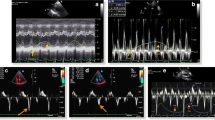Abstract
Purpose of Review
To review the echo-Doppler findings in effusive-constrictive pericarditis (ECP). ECP corresponds to the coexistence of a hemodynamically significant pericardial effusion and markedly reduced compliance of the pericardium, manifested by constrictive physiology post-pericardiocentesis.
Recent Findings
We summarize herein the recent observations regarding the prevalence of ECP based on echocardiography as well as the pre- and post-pericardiocentesis echo-Doppler features of ECP. ECP diagnosed by echocardiography was seen in approximately 15% of patients with ECP pre- and post-pericardiocentesis echo-Doppler findings sharing features with both cardiac tamponade and constrictive pericarditis.
Summary
ECP post-pericardiocentesis is common but its natural history in the current era might be better than previously reported. Further studies and (particularly simultaneous echocardiography-cardiac catheterization) are still critically needed to better understand the underlying hemodynamics of ECP. Moreover, it remains to be determined whether pre- and post-pericardiocentesis echo-Doppler findings can be used to prognosticate or to guide therapy of those undergoing pericardiocentesis.




Similar content being viewed by others
References
Papers of particular interest, published recently, have been highlighted as: • Of importance •• Of major importance
Burchell HB. Problems in the recognition and treatment of pericarditis. J Lancet. 1954;74:465–70.
Spodick DH, Kumar S. Subacute constrictive pericarditis with cardiac tamponade. Dis Chest. 1968;54:62–6.
Wood P. Chronic constrictive pericarditis. Am J Cardiol. 1961;7:48–61.
Hancock EW. Subacute effusive-constrictive pericarditis. Circulation. 1971;43:183–92.
Sagrista-Sauleda J, Angel J, Sanchez A, Permanyer-Miralda G, Soler-Soler J. Effusive-constrictive pericarditis. N Engl J Med. 2004;350:469–75.
Klein AL, Abbara S, Agler DA, et al. American Society of Echocardiography clinical recommendations for multimodality cardiovascular imaging of patients with pericardial disease: endorsed by the Society for Cardiovascular Magnetic Resonance and Society of cardiovascular computed tomography. J Am Soc Echocardiogr. 2013;26:965–1012 e15.
Adler Y, Charron P, Imazio M, et al. 2015 ESC guidelines for the diagnosis and management of pericardial diseases: the task force for the diagnosis and Management of Pericardial Diseases of the European Society of Cardiology (ESC)endorsed by: the European Association for Cardio-Thoracic Surgery (EACTS). Eur Heart J. 2015;36:2921–64.
•• Kim KH, Miranda WR, Sinak LJ, et al. Effusive-constrictive pericarditis after Pericardiocentesis: incidence, associated findings, and natural history. JACC Cardiovasc Imaging. 2018;11:534–41. This was the first study to describe the prevalence of effusive-constrictive pericarditis based on echo-Doppler criteria in a large cohort of patients undergoing pericardiocentesis.
•• Miranda WR, Newman DB, Sinak LJ, et al. Pre- and post-pericardiocentesis echo-Doppler features of effusive-constrictive pericarditis compared with cardiac tamponade and constrictive pericarditis. Eur Heart J Cardiovasc Imaging. 2019;20:298–306. This is study compared the echo-Doppler findings in effusive-constrictive pericarditis to the those seen in cardiac tamponade and constrictive pericarditis, being the first attempt to characterize the pre-pericardiocentesis echocardiographic features of effusive-constrictive pericarditis.
Syed FF, Ntsekhe M, Mayosi BM, Oh JK. Effusive-constrictive pericarditis. Heart Fail Rev. 2013;18:277–87.
Ntsekhe M, Matthews K, Syed FF, et al. Prevalence, hemodynamics, and cytokine profile of effusive-constrictive pericarditis in patients with tuberculous pericardial effusion. PLoS One. 2013;8:e77532.
Nugue O, Millaire A, Porte H, et al. Pericardioscopy in the etiologic diagnosis of pericardial effusion in 141 consecutive patients. Circulation. 1996;94:1635–41.
Ntsekhe M, Shey Wiysonge C, Commerford PJ, Mayosi BM. The prevalence and outcome of effusive constrictive pericarditis: a systematic review of the literature. Cardiovasc J Afr. 2012;23:281–5.
• van der Bijl P, Herbst P, Doubell AF. Redefining effusive-constrictive pericarditis with echocardiography. J Cardiovasc Ultrasound. 2016;24:317–23. The authors assessed the diagnostic yield of echocardiography in tuberculous effusive-constrictive pericarditis, diagnosed during cardiac catheterization.
Miranda WR, Oh JK. Constrictive pericarditis: a practical clinical approach. Prog Cardiovasc Dis. 2017;59:369–79.
Welch TD, Ling LH, Espinosa RE, et al. Echocardiographic diagnosis of constrictive pericarditis: Mayo Clinic criteria. Circ Cardiovasc Imaging. 2014;7:526–34.
Klein AL, Cremer PC. Ephemeral effusive constrictive pathophysiology. JACC Cardiovasc Imaging. 2018;11:542–5.
Appleton C, Gillam L, Koulogiannis K. Cardiac Tamponade. Cardiol Clin. 2017;35:525–37.
Holmes DR Jr, Nishimura R, Fountain R, Turi ZG. Iatrogenic pericardial effusion and tamponade in the percutaneous intracardiac intervention era. JACC Cardiovasc Interv. 2009;2:705–17.
Nishimura RA, Carabello BA. Hemodynamics in the cardiac catheterization laboratory of the 21st century. Circulation. 2012;125:2138–50.
Burstow DJ, Oh JK, Bailey KR, Seward JB, Tajik AJ. Cardiac tamponade: characteristic Doppler observations. Mayo Clin Proc. 1989;64:312–24.
Oh JK, Hatle LK, Seward JB, et al. Diagnostic role of Doppler echocardiography in constrictive pericarditis. J Am Coll Cardiol. 1994;23:154–62.
Author information
Authors and Affiliations
Corresponding author
Ethics declarations
Conflict of Interest
William R. Miranda, Darrell B. Newman, and Jae K. Oh declare that they have no conflict of interest.
Human and Animal Rights and Informed Consent
This article does not contain any studies with human or animal subjects performed by any of the authors.
Additional information
Publisher’s Note
Springer Nature remains neutral with regard to jurisdictional claims in published maps and institutional affiliations.
This article is part of the Topical Collection on Pericardial Disease
Rights and permissions
About this article
Cite this article
Miranda, W.R., Newman, D.B. & Oh, J.K. Effusive-Constrictive Pericarditis: Doppler Findings. Curr Cardiol Rep 21, 144 (2019). https://doi.org/10.1007/s11886-019-1243-4
Published:
DOI: https://doi.org/10.1007/s11886-019-1243-4




